Genetics of Generalized Anxiety Disorder
VerifiedAdded on 2023/04/21
|7
|1525
|186
AI Summary
This article provides comprehensive information on the role of genetics in generalized anxiety disorder, including endophenotypes related to anxiety and the use of selective serotonin reuptake inhibitors (SSRIs) in treatment. It explores the etiological factors in environment-gene interaction models and the genetic correlation between GAD and other anxiety disorders. The article also discusses the significance of early developmental trauma and present stressful events in relation to molecular plasticity markers and GAD. Overall, it highlights the importance of genomics in understanding and treating GAD.
Contribute Materials
Your contribution can guide someone’s learning journey. Share your
documents today.

Running Head: GAD
Generalized anxiety disorder
Students name
University affiliation
Date
Generalized anxiety disorder
Students name
University affiliation
Date
Secure Best Marks with AI Grader
Need help grading? Try our AI Grader for instant feedback on your assignments.
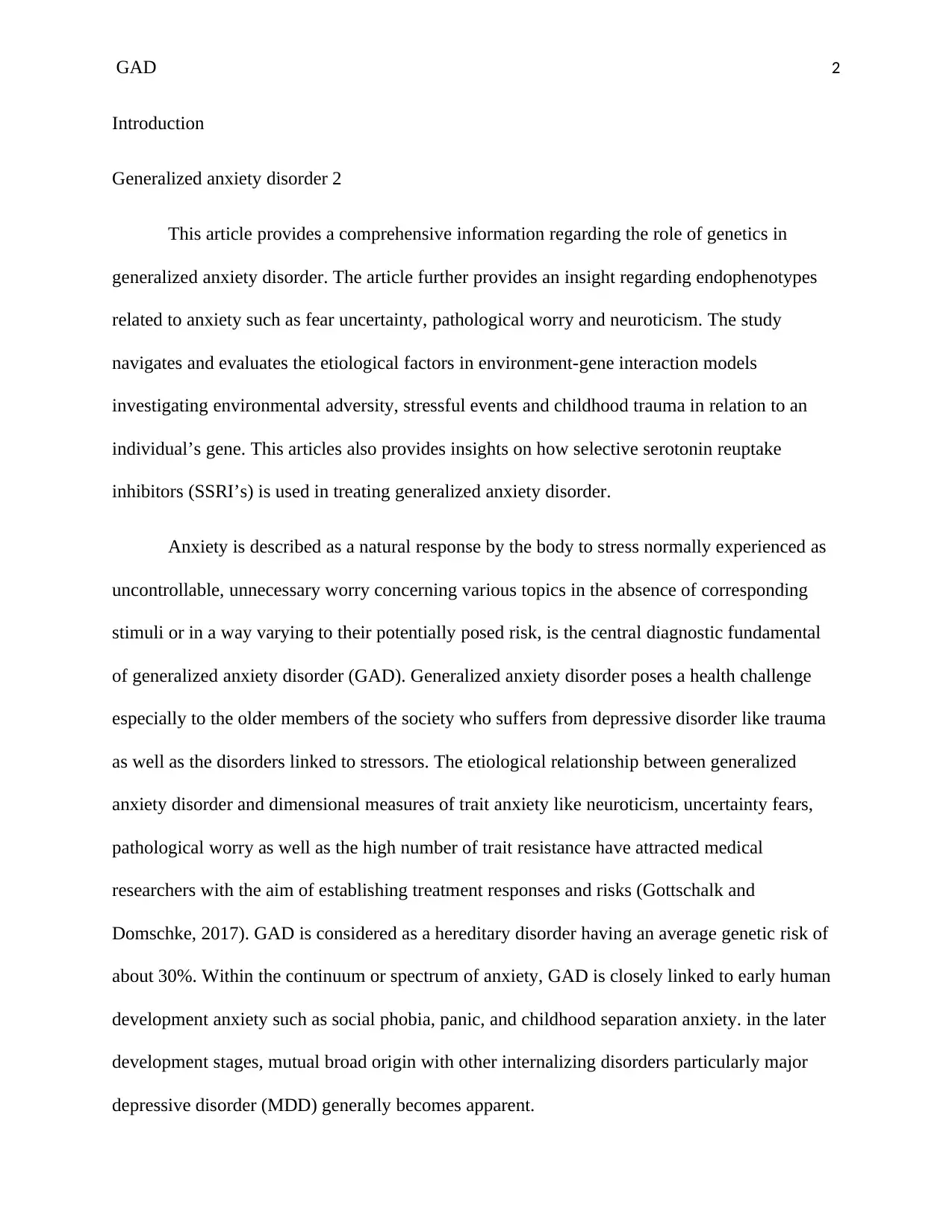
GAD 2
Introduction
Generalized anxiety disorder 2
This article provides a comprehensive information regarding the role of genetics in
generalized anxiety disorder. The article further provides an insight regarding endophenotypes
related to anxiety such as fear uncertainty, pathological worry and neuroticism. The study
navigates and evaluates the etiological factors in environment-gene interaction models
investigating environmental adversity, stressful events and childhood trauma in relation to an
individual’s gene. This articles also provides insights on how selective serotonin reuptake
inhibitors (SSRI’s) is used in treating generalized anxiety disorder.
Anxiety is described as a natural response by the body to stress normally experienced as
uncontrollable, unnecessary worry concerning various topics in the absence of corresponding
stimuli or in a way varying to their potentially posed risk, is the central diagnostic fundamental
of generalized anxiety disorder (GAD). Generalized anxiety disorder poses a health challenge
especially to the older members of the society who suffers from depressive disorder like trauma
as well as the disorders linked to stressors. The etiological relationship between generalized
anxiety disorder and dimensional measures of trait anxiety like neuroticism, uncertainty fears,
pathological worry as well as the high number of trait resistance have attracted medical
researchers with the aim of establishing treatment responses and risks (Gottschalk and
Domschke, 2017). GAD is considered as a hereditary disorder having an average genetic risk of
about 30%. Within the continuum or spectrum of anxiety, GAD is closely linked to early human
development anxiety such as social phobia, panic, and childhood separation anxiety. in the later
development stages, mutual broad origin with other internalizing disorders particularly major
depressive disorder (MDD) generally becomes apparent.
Introduction
Generalized anxiety disorder 2
This article provides a comprehensive information regarding the role of genetics in
generalized anxiety disorder. The article further provides an insight regarding endophenotypes
related to anxiety such as fear uncertainty, pathological worry and neuroticism. The study
navigates and evaluates the etiological factors in environment-gene interaction models
investigating environmental adversity, stressful events and childhood trauma in relation to an
individual’s gene. This articles also provides insights on how selective serotonin reuptake
inhibitors (SSRI’s) is used in treating generalized anxiety disorder.
Anxiety is described as a natural response by the body to stress normally experienced as
uncontrollable, unnecessary worry concerning various topics in the absence of corresponding
stimuli or in a way varying to their potentially posed risk, is the central diagnostic fundamental
of generalized anxiety disorder (GAD). Generalized anxiety disorder poses a health challenge
especially to the older members of the society who suffers from depressive disorder like trauma
as well as the disorders linked to stressors. The etiological relationship between generalized
anxiety disorder and dimensional measures of trait anxiety like neuroticism, uncertainty fears,
pathological worry as well as the high number of trait resistance have attracted medical
researchers with the aim of establishing treatment responses and risks (Gottschalk and
Domschke, 2017). GAD is considered as a hereditary disorder having an average genetic risk of
about 30%. Within the continuum or spectrum of anxiety, GAD is closely linked to early human
development anxiety such as social phobia, panic, and childhood separation anxiety. in the later
development stages, mutual broad origin with other internalizing disorders particularly major
depressive disorder (MDD) generally becomes apparent.
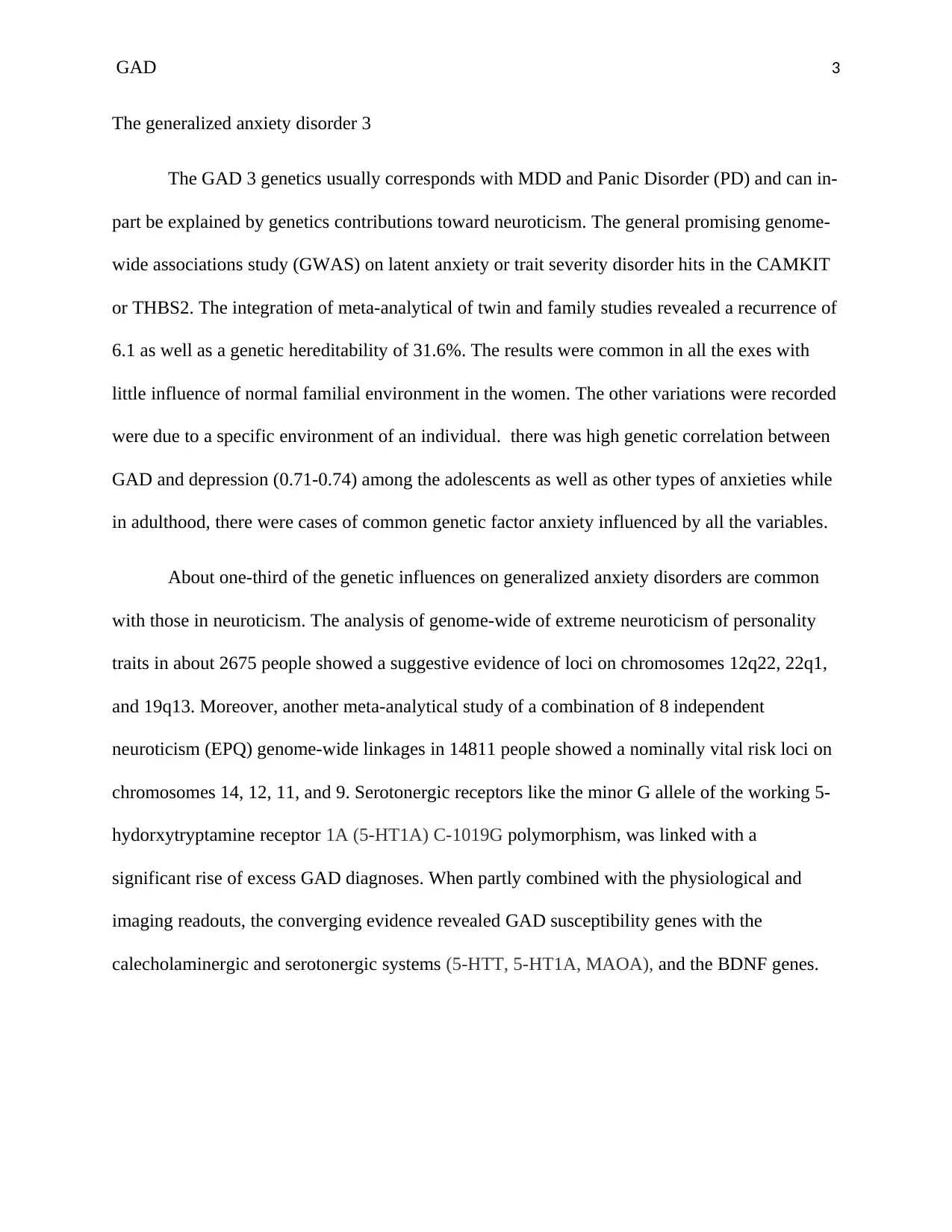
GAD 3
The generalized anxiety disorder 3
The GAD 3 genetics usually corresponds with MDD and Panic Disorder (PD) and can in-
part be explained by genetics contributions toward neuroticism. The general promising genome-
wide associations study (GWAS) on latent anxiety or trait severity disorder hits in the CAMKIT
or THBS2. The integration of meta-analytical of twin and family studies revealed a recurrence of
6.1 as well as a genetic hereditability of 31.6%. The results were common in all the exes with
little influence of normal familial environment in the women. The other variations were recorded
were due to a specific environment of an individual. there was high genetic correlation between
GAD and depression (0.71-0.74) among the adolescents as well as other types of anxieties while
in adulthood, there were cases of common genetic factor anxiety influenced by all the variables.
About one-third of the genetic influences on generalized anxiety disorders are common
with those in neuroticism. The analysis of genome-wide of extreme neuroticism of personality
traits in about 2675 people showed a suggestive evidence of loci on chromosomes 12q22, 22q1,
and 19q13. Moreover, another meta-analytical study of a combination of 8 independent
neuroticism (EPQ) genome-wide linkages in 14811 people showed a nominally vital risk loci on
chromosomes 14, 12, 11, and 9. Serotonergic receptors like the minor G allele of the working 5-
hydorxytryptamine receptor 1A (5-HT1A) C-1019G polymorphism, was linked with a
significant rise of excess GAD diagnoses. When partly combined with the physiological and
imaging readouts, the converging evidence revealed GAD susceptibility genes with the
calecholaminergic and serotonergic systems (5-HTT, 5-HT1A, MAOA), and the BDNF genes.
The generalized anxiety disorder 3
The GAD 3 genetics usually corresponds with MDD and Panic Disorder (PD) and can in-
part be explained by genetics contributions toward neuroticism. The general promising genome-
wide associations study (GWAS) on latent anxiety or trait severity disorder hits in the CAMKIT
or THBS2. The integration of meta-analytical of twin and family studies revealed a recurrence of
6.1 as well as a genetic hereditability of 31.6%. The results were common in all the exes with
little influence of normal familial environment in the women. The other variations were recorded
were due to a specific environment of an individual. there was high genetic correlation between
GAD and depression (0.71-0.74) among the adolescents as well as other types of anxieties while
in adulthood, there were cases of common genetic factor anxiety influenced by all the variables.
About one-third of the genetic influences on generalized anxiety disorders are common
with those in neuroticism. The analysis of genome-wide of extreme neuroticism of personality
traits in about 2675 people showed a suggestive evidence of loci on chromosomes 12q22, 22q1,
and 19q13. Moreover, another meta-analytical study of a combination of 8 independent
neuroticism (EPQ) genome-wide linkages in 14811 people showed a nominally vital risk loci on
chromosomes 14, 12, 11, and 9. Serotonergic receptors like the minor G allele of the working 5-
hydorxytryptamine receptor 1A (5-HT1A) C-1019G polymorphism, was linked with a
significant rise of excess GAD diagnoses. When partly combined with the physiological and
imaging readouts, the converging evidence revealed GAD susceptibility genes with the
calecholaminergic and serotonergic systems (5-HTT, 5-HT1A, MAOA), and the BDNF genes.
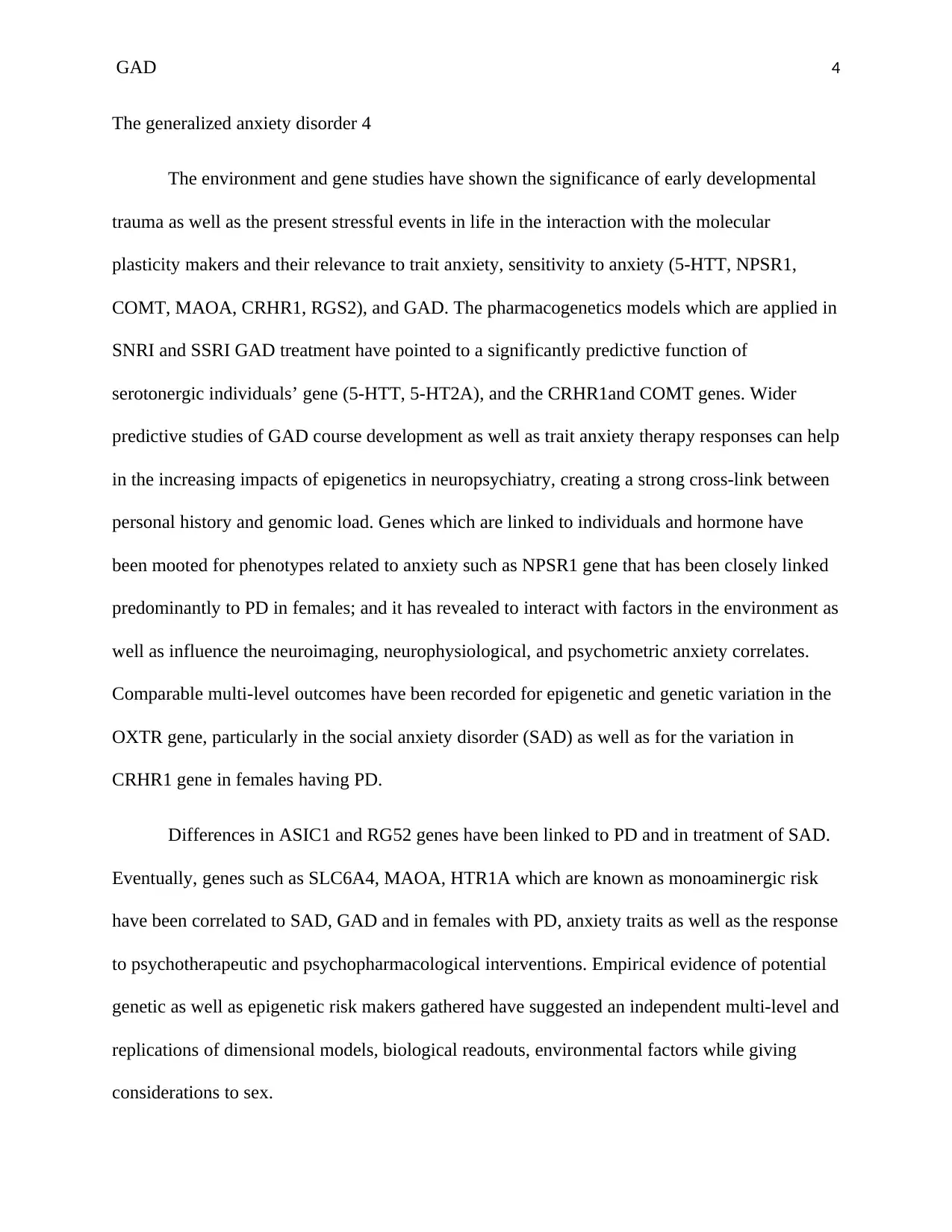
GAD 4
The generalized anxiety disorder 4
The environment and gene studies have shown the significance of early developmental
trauma as well as the present stressful events in life in the interaction with the molecular
plasticity makers and their relevance to trait anxiety, sensitivity to anxiety (5-HTT, NPSR1,
COMT, MAOA, CRHR1, RGS2), and GAD. The pharmacogenetics models which are applied in
SNRI and SSRI GAD treatment have pointed to a significantly predictive function of
serotonergic individuals’ gene (5-HTT, 5-HT2A), and the CRHR1and COMT genes. Wider
predictive studies of GAD course development as well as trait anxiety therapy responses can help
in the increasing impacts of epigenetics in neuropsychiatry, creating a strong cross-link between
personal history and genomic load. Genes which are linked to individuals and hormone have
been mooted for phenotypes related to anxiety such as NPSR1 gene that has been closely linked
predominantly to PD in females; and it has revealed to interact with factors in the environment as
well as influence the neuroimaging, neurophysiological, and psychometric anxiety correlates.
Comparable multi-level outcomes have been recorded for epigenetic and genetic variation in the
OXTR gene, particularly in the social anxiety disorder (SAD) as well as for the variation in
CRHR1 gene in females having PD.
Differences in ASIC1 and RG52 genes have been linked to PD and in treatment of SAD.
Eventually, genes such as SLC6A4, MAOA, HTR1A which are known as monoaminergic risk
have been correlated to SAD, GAD and in females with PD, anxiety traits as well as the response
to psychotherapeutic and psychopharmacological interventions. Empirical evidence of potential
genetic as well as epigenetic risk makers gathered have suggested an independent multi-level and
replications of dimensional models, biological readouts, environmental factors while giving
considerations to sex.
The generalized anxiety disorder 4
The environment and gene studies have shown the significance of early developmental
trauma as well as the present stressful events in life in the interaction with the molecular
plasticity makers and their relevance to trait anxiety, sensitivity to anxiety (5-HTT, NPSR1,
COMT, MAOA, CRHR1, RGS2), and GAD. The pharmacogenetics models which are applied in
SNRI and SSRI GAD treatment have pointed to a significantly predictive function of
serotonergic individuals’ gene (5-HTT, 5-HT2A), and the CRHR1and COMT genes. Wider
predictive studies of GAD course development as well as trait anxiety therapy responses can help
in the increasing impacts of epigenetics in neuropsychiatry, creating a strong cross-link between
personal history and genomic load. Genes which are linked to individuals and hormone have
been mooted for phenotypes related to anxiety such as NPSR1 gene that has been closely linked
predominantly to PD in females; and it has revealed to interact with factors in the environment as
well as influence the neuroimaging, neurophysiological, and psychometric anxiety correlates.
Comparable multi-level outcomes have been recorded for epigenetic and genetic variation in the
OXTR gene, particularly in the social anxiety disorder (SAD) as well as for the variation in
CRHR1 gene in females having PD.
Differences in ASIC1 and RG52 genes have been linked to PD and in treatment of SAD.
Eventually, genes such as SLC6A4, MAOA, HTR1A which are known as monoaminergic risk
have been correlated to SAD, GAD and in females with PD, anxiety traits as well as the response
to psychotherapeutic and psychopharmacological interventions. Empirical evidence of potential
genetic as well as epigenetic risk makers gathered have suggested an independent multi-level and
replications of dimensional models, biological readouts, environmental factors while giving
considerations to sex.
Secure Best Marks with AI Grader
Need help grading? Try our AI Grader for instant feedback on your assignments.
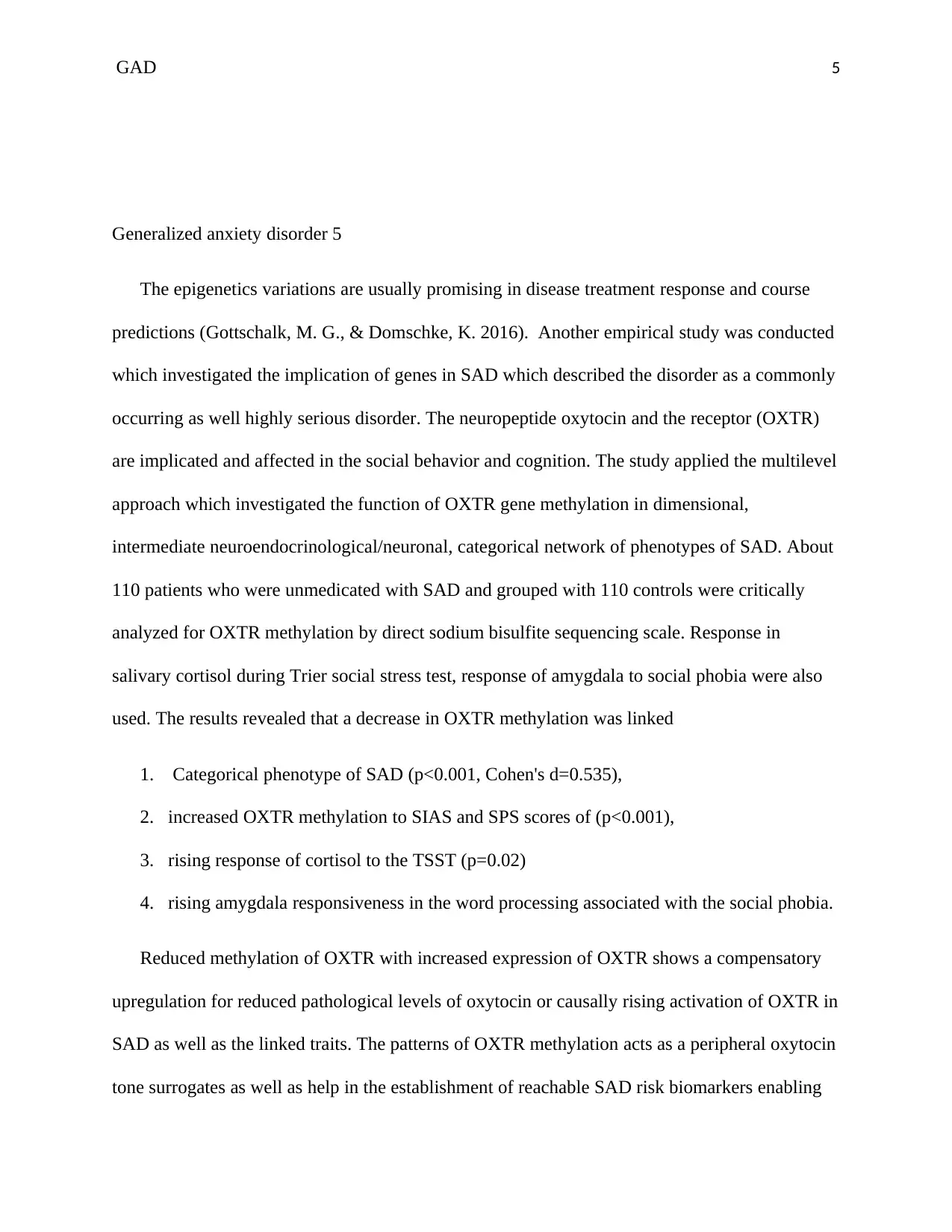
GAD 5
Generalized anxiety disorder 5
The epigenetics variations are usually promising in disease treatment response and course
predictions (Gottschalk, M. G., & Domschke, K. 2016). Another empirical study was conducted
which investigated the implication of genes in SAD which described the disorder as a commonly
occurring as well highly serious disorder. The neuropeptide oxytocin and the receptor (OXTR)
are implicated and affected in the social behavior and cognition. The study applied the multilevel
approach which investigated the function of OXTR gene methylation in dimensional,
intermediate neuroendocrinological/neuronal, categorical network of phenotypes of SAD. About
110 patients who were unmedicated with SAD and grouped with 110 controls were critically
analyzed for OXTR methylation by direct sodium bisulfite sequencing scale. Response in
salivary cortisol during Trier social stress test, response of amygdala to social phobia were also
used. The results revealed that a decrease in OXTR methylation was linked
1. Categorical phenotype of SAD (p<0.001, Cohen's d=0.535),
2. increased OXTR methylation to SIAS and SPS scores of (p<0.001),
3. rising response of cortisol to the TSST (p=0.02)
4. rising amygdala responsiveness in the word processing associated with the social phobia.
Reduced methylation of OXTR with increased expression of OXTR shows a compensatory
upregulation for reduced pathological levels of oxytocin or causally rising activation of OXTR in
SAD as well as the linked traits. The patterns of OXTR methylation acts as a peripheral oxytocin
tone surrogates as well as help in the establishment of reachable SAD risk biomarkers enabling
Generalized anxiety disorder 5
The epigenetics variations are usually promising in disease treatment response and course
predictions (Gottschalk, M. G., & Domschke, K. 2016). Another empirical study was conducted
which investigated the implication of genes in SAD which described the disorder as a commonly
occurring as well highly serious disorder. The neuropeptide oxytocin and the receptor (OXTR)
are implicated and affected in the social behavior and cognition. The study applied the multilevel
approach which investigated the function of OXTR gene methylation in dimensional,
intermediate neuroendocrinological/neuronal, categorical network of phenotypes of SAD. About
110 patients who were unmedicated with SAD and grouped with 110 controls were critically
analyzed for OXTR methylation by direct sodium bisulfite sequencing scale. Response in
salivary cortisol during Trier social stress test, response of amygdala to social phobia were also
used. The results revealed that a decrease in OXTR methylation was linked
1. Categorical phenotype of SAD (p<0.001, Cohen's d=0.535),
2. increased OXTR methylation to SIAS and SPS scores of (p<0.001),
3. rising response of cortisol to the TSST (p=0.02)
4. rising amygdala responsiveness in the word processing associated with the social phobia.
Reduced methylation of OXTR with increased expression of OXTR shows a compensatory
upregulation for reduced pathological levels of oxytocin or causally rising activation of OXTR in
SAD as well as the linked traits. The patterns of OXTR methylation acts as a peripheral oxytocin
tone surrogates as well as help in the establishment of reachable SAD risk biomarkers enabling
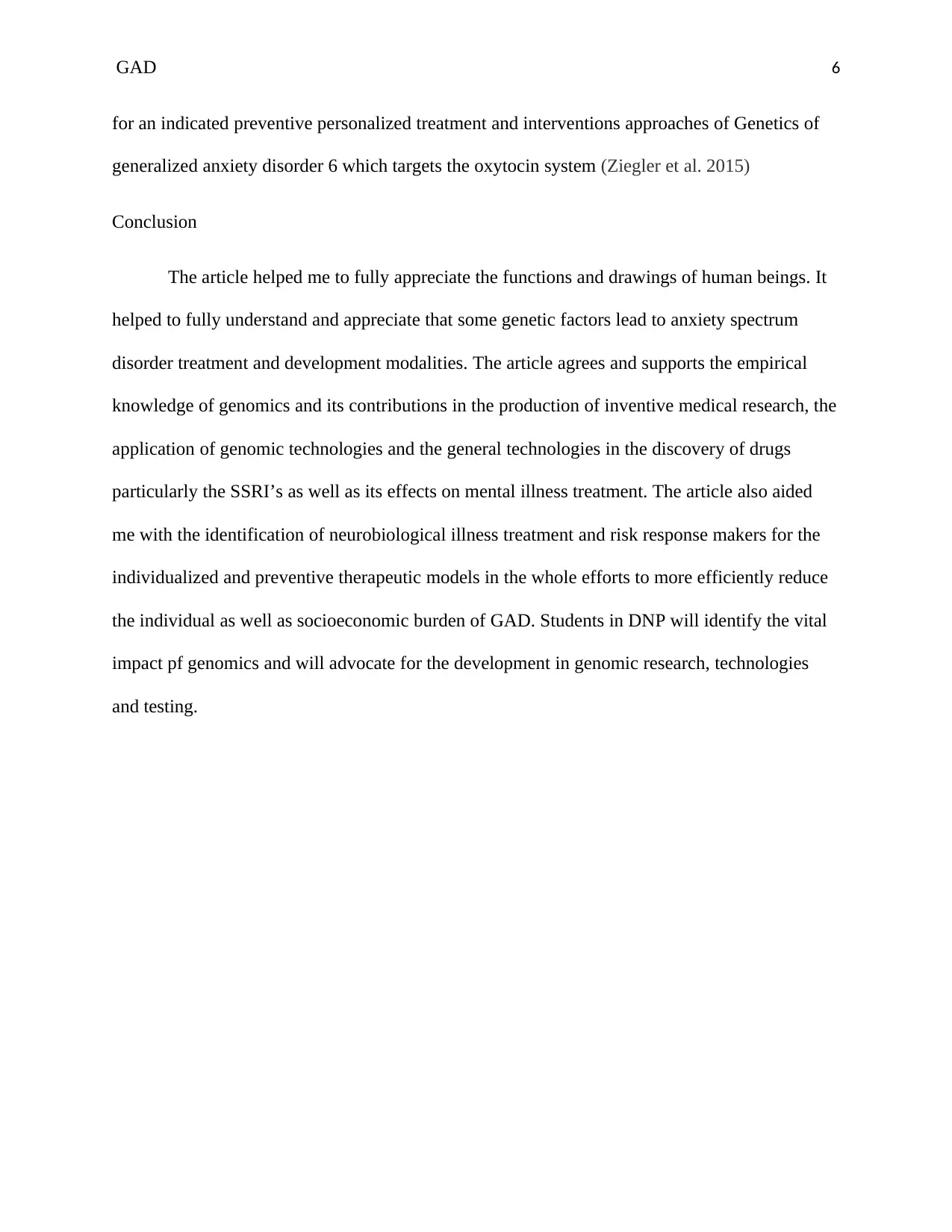
GAD 6
for an indicated preventive personalized treatment and interventions approaches of Genetics of
generalized anxiety disorder 6 which targets the oxytocin system (Ziegler et al. 2015)
Conclusion
The article helped me to fully appreciate the functions and drawings of human beings. It
helped to fully understand and appreciate that some genetic factors lead to anxiety spectrum
disorder treatment and development modalities. The article agrees and supports the empirical
knowledge of genomics and its contributions in the production of inventive medical research, the
application of genomic technologies and the general technologies in the discovery of drugs
particularly the SSRI’s as well as its effects on mental illness treatment. The article also aided
me with the identification of neurobiological illness treatment and risk response makers for the
individualized and preventive therapeutic models in the whole efforts to more efficiently reduce
the individual as well as socioeconomic burden of GAD. Students in DNP will identify the vital
impact pf genomics and will advocate for the development in genomic research, technologies
and testing.
for an indicated preventive personalized treatment and interventions approaches of Genetics of
generalized anxiety disorder 6 which targets the oxytocin system (Ziegler et al. 2015)
Conclusion
The article helped me to fully appreciate the functions and drawings of human beings. It
helped to fully understand and appreciate that some genetic factors lead to anxiety spectrum
disorder treatment and development modalities. The article agrees and supports the empirical
knowledge of genomics and its contributions in the production of inventive medical research, the
application of genomic technologies and the general technologies in the discovery of drugs
particularly the SSRI’s as well as its effects on mental illness treatment. The article also aided
me with the identification of neurobiological illness treatment and risk response makers for the
individualized and preventive therapeutic models in the whole efforts to more efficiently reduce
the individual as well as socioeconomic burden of GAD. Students in DNP will identify the vital
impact pf genomics and will advocate for the development in genomic research, technologies
and testing.
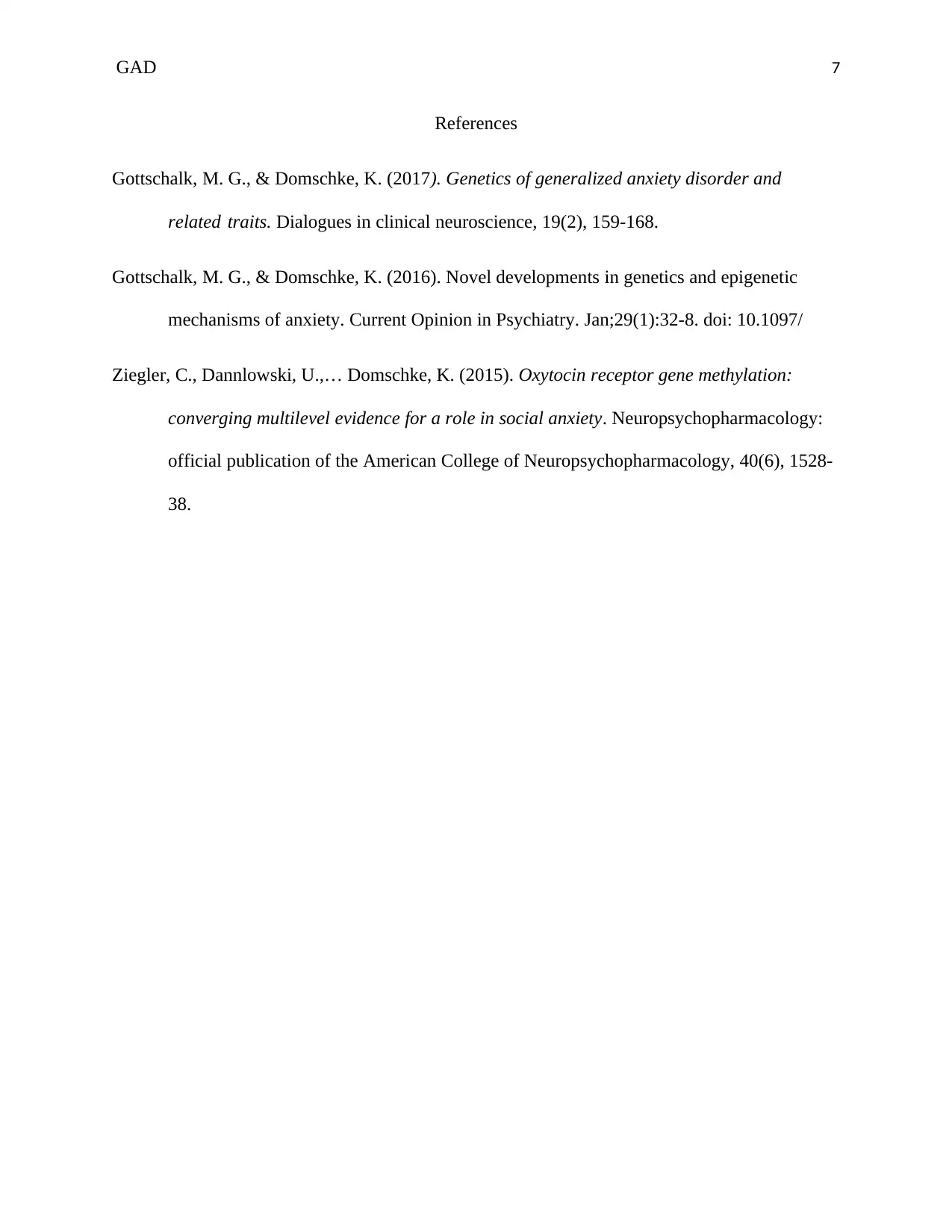
GAD 7
References
Gottschalk, M. G., & Domschke, K. (2017). Genetics of generalized anxiety disorder and
related traits. Dialogues in clinical neuroscience, 19(2), 159-168.
Gottschalk, M. G., & Domschke, K. (2016). Novel developments in genetics and epigenetic
mechanisms of anxiety. Current Opinion in Psychiatry. Jan;29(1):32-8. doi: 10.1097/
Ziegler, C., Dannlowski, U.,… Domschke, K. (2015). Oxytocin receptor gene methylation:
converging multilevel evidence for a role in social anxiety. Neuropsychopharmacology:
official publication of the American College of Neuropsychopharmacology, 40(6), 1528-
38.
References
Gottschalk, M. G., & Domschke, K. (2017). Genetics of generalized anxiety disorder and
related traits. Dialogues in clinical neuroscience, 19(2), 159-168.
Gottschalk, M. G., & Domschke, K. (2016). Novel developments in genetics and epigenetic
mechanisms of anxiety. Current Opinion in Psychiatry. Jan;29(1):32-8. doi: 10.1097/
Ziegler, C., Dannlowski, U.,… Domschke, K. (2015). Oxytocin receptor gene methylation:
converging multilevel evidence for a role in social anxiety. Neuropsychopharmacology:
official publication of the American College of Neuropsychopharmacology, 40(6), 1528-
38.
1 out of 7
Your All-in-One AI-Powered Toolkit for Academic Success.
+13062052269
info@desklib.com
Available 24*7 on WhatsApp / Email
![[object Object]](/_next/static/media/star-bottom.7253800d.svg)
Unlock your academic potential
© 2024 | Zucol Services PVT LTD | All rights reserved.